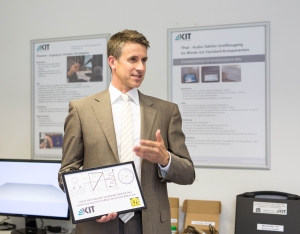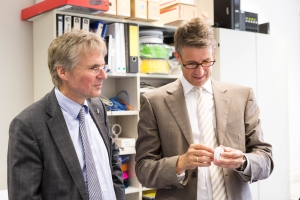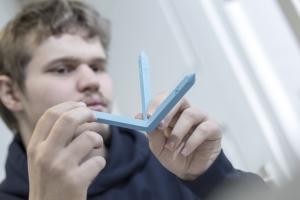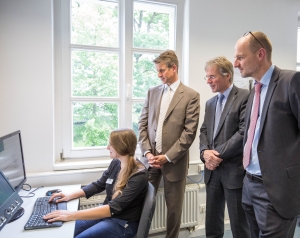The new Accessibility Lab develops and realizes innovative concepts for people with a sight impairment. The facility belongs to the SZS (Study Centre for the Visually Impaired) of KIT and combines research, teaching, and support in the fields of assistive technologies, barrier-free access to information, and adapted working environments for blind and partially sighted people. Setting up the Accessibility Lab was possible thanks to a donation from entrepreneur Stefan Quandt.
“The new Accessibility Lab of the Study Centre for the Visually Impaired reduces barriers and improves research: Now, students with a visual impairment can benefit from a still better working environment. At the same time, they can contribute, with their skills and experience, to the research and development of new assistive technologies – a benefit to all people involved. I am happy that my funding of the SZS strengthens its role as an innovation driver,” says entrepreneur Stefan Quandt, a KIT alumnus.
“Assistive Technologies and a barrier-free access to information supports blind and partially sighted people in their everyday life and can help them study autonomously. The Study Centre for the Visually Impaired has been active in the development of corresponding solutions for many years. In the SZS Accessibility Lab, we can further extend and intensify these activities. I would like to express my deepest gratitude to Stefan Quandt, our sponsor and alumnus, for his support that made it possible for us to set up this lab,” stresses Professor Holger Hanselka, President of KIT.
The SZS Accessibility Lab includes a lab for tactile and 3-D printing, a test lab for research and development, and the facilities required to set up assistive working and lab environments.
When developing assistive technologies, the Accessibility Lab cooperates with manufacturers of aids for handicapped persons. Another Accessibility Lab initiative is setting up a network with other universities and offering training courses that inform about accessible teaching materials to educational facilities. “Stefan Quandt’s donation allows us to buy state-of-the-art devices, such as a 3-D printer working with various printing technologies, says Professor Rainer Stiefelhagen, Director of SZS who also holds the Professorship of “IT Systems for Visually Impaired Students”. “At the same time, the KIT provided us with new rooms. This means that we can extend and intensify our research and development activities related to assistive systems for people with a sight impairment.” At the KIT Institute for Anthropomatics and Robotics (IAR), Professor Rainer Stiefelhagen also directs the “Computer Vision for Human-Computer Interaction Lab” research group.
IT-based assistive technologies can be of great help to visually impaired people. The KIT scientists developed navigation solutions as well as camera systems for the recognition of objects and obstacles. In addition, a vibrating belt with associated software that passes information to blind persons by using different vibration patterns, is under development. It is supposed to help them navigate the world independently. In addition, the Accessibility Lab scientists work on control and usability concepts for large-surface Braille displays – these are output devices for Braille, the tactile reading / writing system for the blind – as well as on programs that can recognize images, photos, and graphics and automatically create image descriptions or vector graphics that can be printed as tactile objects. In order to produce tactile materials, the Accessibility Lab uses special devices that print documents in color and, at the same time, emboss tactile points, lines, and surfaces.
For students with visual impairments, especially in the subjects of mathematics, information science, natural sciences, and engineering, the Accessibility Lab develops various aids such as a web application that converts literature to selected accessible formats. In the print lab, three-dimensional, tactile teaching materials such as a 3-D plan of the KIT Campus are created. New technical devices, e.g. tablets and smart watches, are tested and extended to explore new ways for addressing the needs of blind and partially sighted users. In the Accessibility Lab, entire lab or working environments can be simulated for sight-impaired students in order to adapt them individually and make them accessible to these users. For this purpose, measuring instruments are prepared by adding voice output so that they can be used by blind and partially sighted students in natural sciences such as physics or chemistry.

Entrepreneur Stefan Quandt: His support made it possible to set up the Accessibility Lab (Photo: Lydia Albrecht/KIT)

Stefan Quandt and Professor Holger Hanselka, President of KIT (Photo: Lydia Albrecht/KIT)

In the Laboratory for Tactile and 3-D Printing which is part of the Accessibility Lab, tactile teaching materials can be produced, such as a 3-D coordinate system that facilitates spatial thinking (Photo: Andrea Fabry)
In close partnership with society, KIT develops solutions for urgent challenges – from climate change, energy transition and sustainable use of natural resources to artificial intelligence, sovereignty and an aging population. As The University in the Helmholtz Association, KIT unites scientific excellence from insight to application-driven research under one roof – and is thus in a unique position to drive this transformation. As a University of Excellence, KIT offers its more than 10,000 employees and 22,800 students outstanding opportunities to shape a sustainable and resilient future. KIT – Science for Impact.

